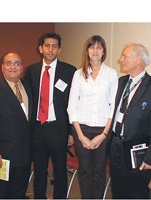Fast Fashion, PLM Are Hot Topics at Tech Conference
NEW YORK—Fast-fashion retailing and an increasingly savvy consumer are pushing traditional retailers and their vendors to adopt new technologies at a rapid rate, but those companies need to examine their businesses to make the right investments in technology.
That was the word from industry experts meeting recently at a technology conference in New York.
“If your lead times aren’t cut in half within five years, you’re going to be in trouble,” said Michael Barrett of Boston-based AMR Research in his opening keynote address.
“The fast-fashion winners of today are not necessarily tech stories,” he continued. “They don’t start from scratch. [Spanish retailer] Zara has 300 designers that modify and tweak [existing] styles. They also create a sense of urgency with ’planned obsolescence’ by intentionally making short runs of certain styles.”
Barrett was one of several leading analysts, manufacturers, retailers and technology providers who gathered to participate in about 30 sessions to discuss how technology can help companies compete in the global marketplace. Apparel magazine hosted the Tech Conference, which was held Nov. 8–9 at New York’s Fashion Institute of Technology.
Barrett said that emerging technologies such as PLM (product lifecycle management) software will be key to helping companies streamline their production pipelines, but he also cautioned that such technologies are not silver bullets to success.
Despite the call for speed-to-market, Barrett noted that it is not the only factor for apparel manufacturers to consider. “You have to make decisions by brands and distribution channels,” he said. “Allocate development resources based on speed. Think about the types of products that fit in with what you do.”
Still, more savvy consumers are pushing the need for speed, said Barrett.
“They are becoming harder to pinpoint,” he said. “They are trading up and down. They’re seeing new forms of retail open up before them.”
Chad Doiron, IT strategist for Kurt Salmon Associates, called these customers “super consumers” because they have lots of purchasing power and are extremely mobile, adapting to new technologies away from desktops and laptops. They can shop at Wal-Mart one day and at Nordstrom the next. Some of the reasons for their behavior may be linked to the gap between their online and in-store retail experiences, said Doiron.
“In general, the in-store retail experience has not changed much over the past 25 years,” Doiron said. “With the Internet and other technology, they have unsurpassed options now and can play retailers off another. They’re super demanding and have a mindset to expect a high level of service.”
Doiron said the online channel continues to grow, explaining that more than 90 percent of shoppers in the United States have purchased something over the Internet during the past year and up to 70 percent have used it to research in-store purchases. As one point of impact, he noted that more music is being bought online than in CD format.
Still, he said retailers are making in-roads with the shopping experience. Macy’s is starting to use handheld computers on the sales floor. Chains such as The Container Store issue handhelds to customers so they can scan large items themselves. Japanese department store chain Mitsukoshi has voice-activated handheld devices that can give customers an idea of sizes available on clothing and provide them with invoices.
PLM draws interest
One way many are reacting, Doiron said, is with emerging product lifecycle management software, which is an Internet-based database system that tracks all production processes so managers and trading partners can see one view of what’s happening. Barrett said company surveys indicated that about 35 percent of apparel companies are considering implementing PLM during the next 24 months.
“There’s a new dimension of complexity [brought on by offshore sourcing] with more moving parts and more room for error,” noted Lectra USA President David Rode. “PLM synchronizes the supply chain and allows for true global collaborations, combining business and process management. We can get so busy working out the collection, we forget to figure out if we can make money. This can help.”
PLM expert Fred Isenberg of Miami Lakes, Fla.–based New Generation Computing, further illustrated the point by explaining the average product lifecycle contains about 150 steps, 52 percent of which are “non-value-added.”
“In other words, half of what you do, you don’t need to do,” said Isenberg. “You’re handling the same information two and three times.”
PLM is still early in the adoption stages in the apparel industry, but Isenberg said early adopters such as Armani A/X Exchange have shown positive results, reducing development cycles by 25 percent and business processes by 40 percent.
“The key is to manage without costly errors,” he said. “It’s much better than getting together once a week and blaming each other for problems.”
3-D taking shape.
The accent on speed is also being felt on the design side. Companies such as Malibu, Calif.–based Shapely Shadow, which presented a seminar on “Fast Styles,” showed the latest advancements in fitting technology using body-scanning data and 3-D software.
The company’s Fast Fit system conducts virtual fitting sessions based on animation technology. The system uses simple digital images of a fit model to allow designers and factory-based staff to collaborate via the Internet on the fit and form of a garment. Users can rotate, twist and turn the model as well as zoom in on key areas of a garment.
“Only 30 percent of prototypes go into production,” said Shapely Shadow’s Roxy Starr. “This can help reduce the number of counter samples as well as shipping costs. We need the visual reference. It beats staying up until 2 a.m. talking to Hong Kong about fit.”
The company also unveiled a series of stock dress forms it is producing based on Cary, N.C.–based TC2’s “Size USA” survey, which took 3-D body scans of 12,000 subjects across the country to measure shapes and sizes of Americans, updating a 50-year-old standard set by ASTM (the association previously known as the American Society for Testing and Materials).
“Today, you have 33 different size 8s. Many of the forms on the market are not a true representation of what America is. We’re trying to correct that,” said Ilona Foyer, founder of Shapely Shadow.
“It’s not like the old days,” added Ram Sareen, chief executive officer of Los Angeles–based Tukatech. “We can now clone the fit model. Sixty-three percent of the cycle time is for getting approvals, so there are better options now.” Sareen gave a demo of the company’s e-Fit simulator, which allows companies to animate fit models to visualize how a prototype garment reacts to movement.
Optitex showed a similar product and said it will open up a lot of its technologies to the home sewing market. Client Lovie Couture LLC conducted a seminar showing how it used Optitex softwear to produce made-to-measure garments for the dance market.
’All Star’ Trina Turk to Debut NYC Store
Los Angeles designer Trina Turk was sitting pretty at the Fashion Institute of Technology in New York last week. The designer had just been presented an “All Star” award at Apparel magazine’s annual Tech Conference and was in the city preparing for the big opening of her first New York store, a 2,500-square-foot boutique in the city’s Meatpacking District.
Turk’s award was one of 10 doled out at FIT. Her $34 million company was singled out for its design innovation as well as for keeping its corporate engines well managed. The California Fashion Association nominated the company.
Turk’s third retail venue will be “more earthy” than her Palm Springs and Los Angeles boutiques. “I don’t know how else to describe it,” said Turk.
The store will have a fireplace, skylights and terra-cotta tiles. Turk enlisted designer Jonathan Adler, known for giving the Parker Palm Springs hotel a “hippie-chic” appeal. Like Turk, Adler incorporates vintage themes with modern aesthetics, so the store will feature whites blended with a smattering of teals, mustards and other snappy colors.
Turk expects to have a built-in base of customers for the store. “We’ve been getting lots of inquiries and e-mails. We have a lot of stores that carry the collection, but this will be a full representation,” she said.
The store will open Nov. 28 at 67 Gansevoort St. To promote the opening, Turk is putting on a shopping-spree contest and will conduct a fundraiser benefiting Friends of the High Line, an organization formed to conserve a 1.5-mile elevated railway on Manhattan’s West Side























